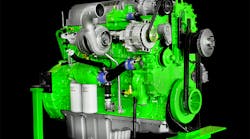Citing “the regulatory overreach” of the Obama administration, the Environmental Protection Agency announced a proposal to exempt gliders kits from the Phase 2 greenhouse gas rule for heavy- and medium-duty trucks.
The announcement drew criticism from Glen Kedzie, energy and environmental affairs counsel for American Trucking Associations (ATA). He spoke to Fleet Owner as he was still reviewing EPA’s 20-page proposal, but suggested legal challenges seemed inevitable and the decision could open the door for states such as California to take regulatory action.
“The agency’s position supporting the continued growth of the glider kit industry that produces the highest emitting equipment on our nation’s highways is perplexing,” he said.
EPA said that gliders should not be regulated as “new motor vehicles” or “new motor vehicle engines” under the Clean Air Act.
“Gliders not only provide a more affordable option for smaller owners and operators, but also serve as a key economic driver to numerous rural communities.” said Scott Pruitt, EPA’s administrator.
The Phase 2 rule, issued by EPA and the National Highway Traffic Safety Administration in 2016, called for rebuilt engines installed in gliders to satisfy emission standards in the year they were assembled applicable to new engines. Though there was not an immediate challenge at the time the rule was issued, earlier this year Fitzgerald Glider Kits appealed to Pruitt, saying it would effectively put it and similar firms out of business.
ATA's Kedzie noted the trucking industry spent three years meeting with the government officials, environmental groups, and other stakeholders to develop a multi-phased rule that created certainty through 2027.
He said ATA supports the rule as originally issued and said EPA’s decision could invite California “to step into this space.”
Kedzie also worried about other negative ramifications in the coming years.
“This is just a moment in time. Nothing stays constant in Washington – that goes for the management of EPA,” Kedzie said. Likewise, changes in the make-up of Congress and the White House could lead to “a big push to make up for a lost opportunity as a result of this administration.”
He added the fleets paying higher prices for new, cleaner equipment are being undercut by those turning to gliders.
EPA estimates that about 10,000 gliders are manufactured annually and make up about 5% of the entire Class 8 truck market. However, the agency previously said gliders could account about one-third of all nitrogen oxides and particulate matter emissions from the sector.
Drew Kodjak, executive director of the International Council on Clean Transportation, said glider kits are “enticing” to a segment of the trucking industry because they are 25% cheaper to buy versus new truck. He spoke at a Securing America’s Future Energy (SAFE) press event in Washington, D.C.
“Not having a DPF [diesel particulate filter], SCR [selective catalytic reduction] system and urea [diesel exhaust fluid or DEF] tank can save $10,000 in cost,” he explained. Kodjak added gliders can “poke a huge hole” in the fuel saving expectations of the GHG rule.
The agency will hold a public hearing on Dec. 4. Public comments will be accepted until Jan. 5.




